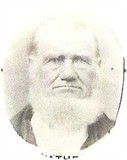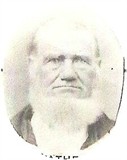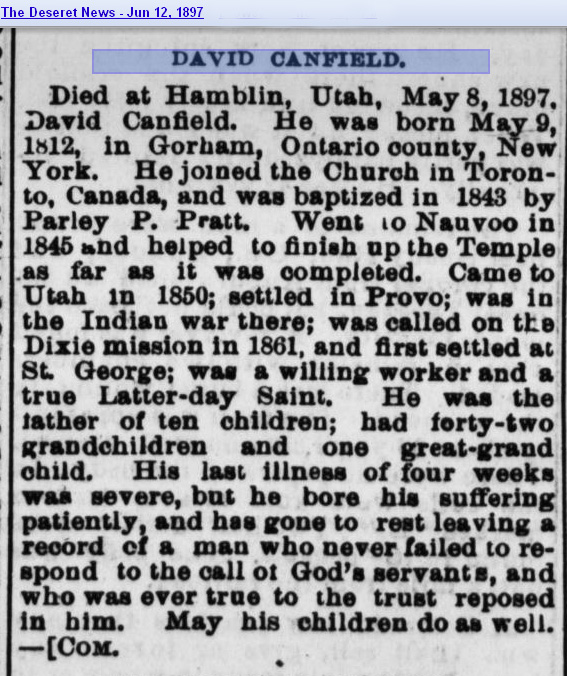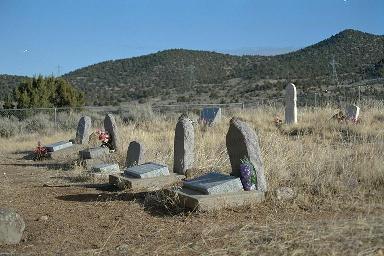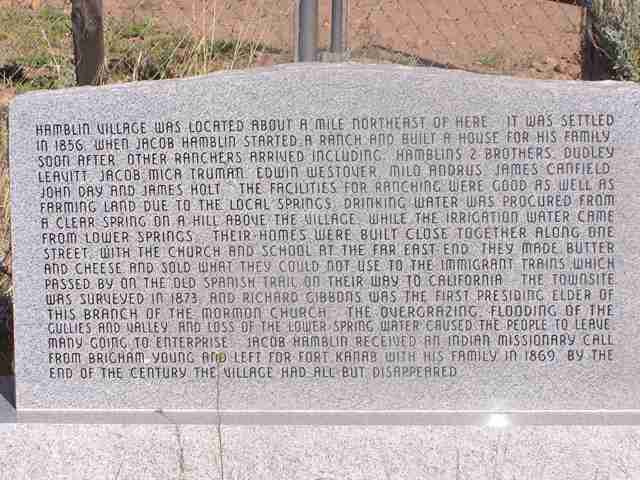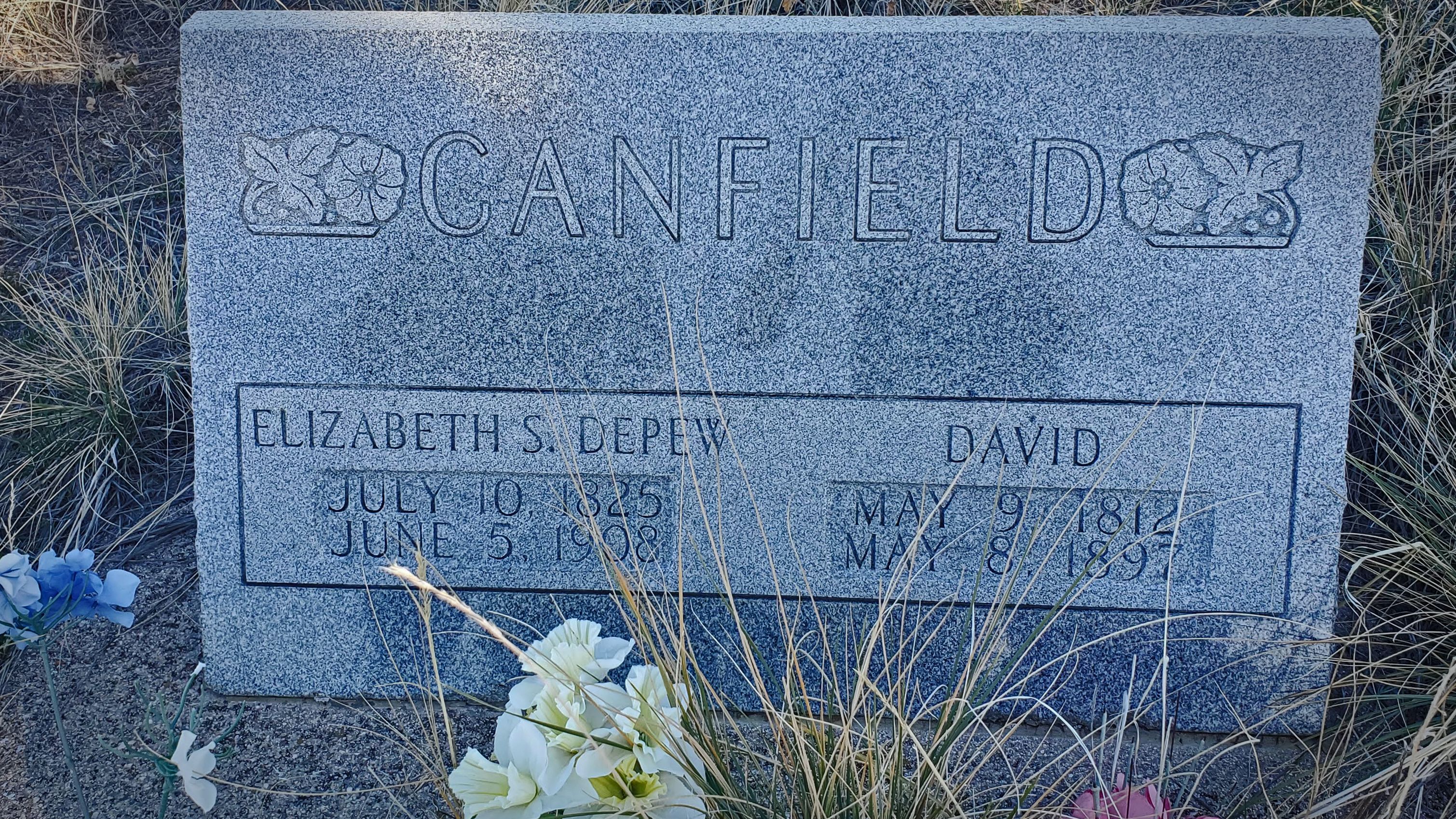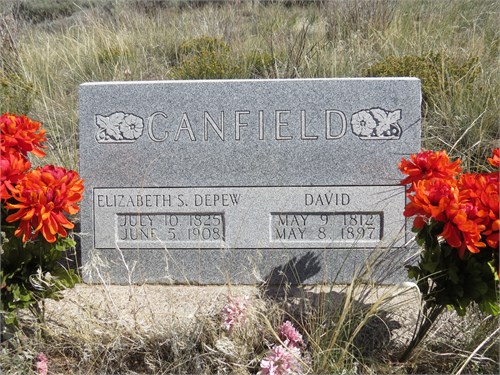David left home when he was twelve years old and went to Canada and lived with his uncle who was an ax maker and ships carpenter. He worked on the Great Lake District much of his early life, following his trade of ships, carpenter and blacksmith. He also worked on the Erie Canal as a bridge builder.
While in Canada, he fell in love and married a young Irish girl named Sally Mathison. They had two girls, Jane born about 1834 and Susannah about 1836.
It was at this time that he met the Mormon missionaries and learned of the restored Gospel and he was baptized by Parley P. Pratt in Jun 1836.
In 1837, the United States and the English in Canada were having problems and a war broke out. The English found out that David was born in the States and was there working. They called him a rebel and his Canadian friends warned him they were after him. From this time on, he had no peace or rest and was always running and hiding from the English. He enlisted with a group of "Rebels" as they were known, and was prescribed, which possibly means he was a leader of the group and gave orders or directions, fighting with the States against the English. Things got pretty hot for him and he decided he had better leave Canada. His wife was pregnant so he made arrangements to leave his family with his wife's grandmother Mathison. With the help of his Canadian friends, they put him in a large barrel that was used to haul molasses and put him on a wagon and surrounded him with barrels full of molasses and took him across the border into the States. For years, the Queens soldiers were looking for him and all other men of his company. He had received from the States a Commission as an Officer of an Insurgent Corporal.
After the war was over, he went back to Canada to get his wife and children. His friends there told him what had happened... his wife had died shortly after giving birth to a baby boy and the baby died also. They took him to the grave where they had buried them both together. The grandmother Mathison had then taken the two little girls and gone back to Ireland without leaving any means of
contacting her.
After losing everything, he had only his church and his work to begin again. He went to work as a carpenter around the Great Lakes and finally drifted into Chicago and then into Ohio. During this time, he met and married Elizabeth Story Depew, age 19 on 1 Oct 1843 in Bryan, Williams Co., Ohio. She was a daughter of John Horace Depew and Lucy Lonsberre. Needless to say, the Depew family being French Huegenots, were most unhappy about this marriage of Elizabeth to David Canfield, a Mormon.
Sometime after their marriage, David and Elizabeth moved to Defiance, Ohio where their first child, David Jr. was born. They then moved to Chicago for work. They eventually moved to Nauvoo, Illinois to join the saints and David worked on the Nauvoo Temple. They were very destitute of material things and, with the persecution the saints were receiving, it was hard for the family. Just prior to the saints being driven out of Nauvoo, Brigham Young told David to return to Chicago and earn enough means with which to get a team and wagon. This, David and his family did, and it was there in Chicago.
The fall of 1849 found them at Winter Quarters. During the summer of 1850, they crossed the plains with an ox team and wagon in the Aaron Johnson Company. Also in the company was Jacob Hamblin, Dan Tyler, Edison Barney and William Cameron. After reaching Salt Lake, President Young sent David and his family to help settle Provo. They arrived in Provo just in time for James, their fourth child, to be born in a wagon box on 9 Oct 1850. He was the first white baby born in Provo. At this time a great loss came to them when their twelve year old boy, David Jr., died on 14 Jun 1856. Just seven months later on 17 Jan 1857, their second child Ellen Elizabeth, eleven years old, died and she was buried where Brigham Young University is now.
While living in Provo, David worked as City Alderman during 1851-1852 and as Councilor in 1853-1854. While living here in Provo, their next five children were born. Harriet Elma was born 5 Apr 1859 and died 12 Dec 1859, and is buried in the Provo City Cemetery.
During the October General Conference in 1861, Brigham Young called 360 families to go and settle the Dixie Mission. David and Elizabeth and their family received the call and they made ready for the trip. Clara was just two days old when they started the trip on the 14 Nov 1861. It was necessary for them to go at that time so they would have company to travel with. They had a fairly good team of oxen and figured they could make the trip. Rough roads and a heavy load... gave the oxen out between Conn Creek and Cove Fort. They made it as far as Beaver and stayed a week at the home of Daniel Tyler, who had crossed the plains with them. They then stopped a day or two at Parowan and again at the home of Father Corry at Cedar City.
Moroni, who was thirteen years old, was driving an outfit for James Holliday who settled in Grafton, Utah and as soon as they could unload he sent Moroni back with an outfit to help his father. Only through the kindness of Mr. Holliday were they able to make the last of the journey to Dixie. Coming into Washington, they stopped at the home of John Price for a day or two and then went onto St. George. They located at the spring above the Pace farm east of St. George. They were there for the first Christmas held in St. George.
It rained very heavy that first winter and was very difficult to keep things dry and keep fires going. The ground was so boggy where the city now stands, that it was hard to get around. They had to keep on the beaten trails and they often had to lift the animals out of the mud. The grass grew tall on the black hills around St. George and at times you couldn't see the black rocks for the grass. Oxen and cattle were wintered there. When the grass was gone on the east black ridge, the livestock was moved over to the west side of St. George on the black hill where the "D" is.
David was a good friend of Jacob Hamblin and he knew of David's ability as a carpenter, so he asked David to build him a home on the Santa Clara Creek.
The Canfield family moved over there and settled around what was called "Hunts Place" and the "Foster Ranch". While living on the Santa Clara creek, they experienced a great flood. It rained and rained. Elizabeth became so uneasy about it that as the family were having their prayer before going to bed, she asked for protection from the Lord. After going to sleep, Elizabeth awoke suddenly and shook David saying, "Wake up, wake up David, I have been warned to take the family to higher ground. Hurry wake the children and warn the neighbors, then you and the boys climb the mountain. I will go ahead with the rest of the family." David and the boys alerted the neighbors, some laughed and went back to sleep while others took the warning and went to safe ground. After it was all over with, they helped gather up the bodies. Some they could never find. James never forgot the experience of trying to unwrap the arms of a youngster from around a tree, or the look on his mother Elizabeth's face as she cleaned and cared for the bodies of young and the old as they were brought in.
While living in Santa Clara, David Canfield and his boys build the old Jacob Hamblin home. They cut and hauled timber from Pine Valley Mountain and it was difficult work. The boys gathered and lifted rock, but laughed and had a good time. David became a little angry when Jacob could not pay them as promised for their labors and so David, in disgust, moved his family into the home and lived there for two or three years.
They then moved to Pine Vally. From there they moved a few more miles to the north, to the Meadows or Hamblin as it was called. They lived in a wagon box and what shelter they could fix up around it to keep the hot sun and weather out. They longed for a home of their own and so they worked and saved to get enough to build a home but it was hard in such a wilderness area. It was here the Jacob
Hamblin finally paid David for building his home in Santa Clara. David and his boys now built a nice home of their own in Hamblin. Things seemed a little easier for awhile. Their little cow and sheep herd grew and they made cheese and butter to sell or trade. Travelers going and coming from Pioche, Nevada to St. George and other places would stop at the Canfield home for meals or to pick up supplies of cheese, butter, vegetables and etc.
David did carpenter work and blacksmith work for a living. One day as he was working on a roof, a sudden, heavy rain storm came up and he was caught in it. He developed a bad cold and never recovered. He died on 8 May 1897, at age 85, and was buried next to his son Moroni who had died the 28 Jun 1893 at age 45 and was buried in the Hamblin cemetery.
Copied from the Deseret News May 29, 1897
David Canfield - Died at Hamblin May 8, 1897. He was born May 9, 1812 in Gorham, Ontario County, New York. He joined the church in Toronto, Canada, and was baptized in 1843 by Parley P. Pratt. Went to Nauvoo in 1845 and helped to finish up the temple as far as it was completed. Came to Utah in 1850. Settled in Provo. Was in the Indian War there. Then was called to the Dixie Mission in 1861 and first settled at St. George, Utah. He was a willing worker and a true Latter-day Saint. He was the father of ten children. Had forty-two grandchildren and one great-grandchild. His last illness of four weeks was severe, but he bore his suffering patiently and has gone to rest leaving a record of a man who never failed to respond to the call of God, and who was ever to the trust reposed in
him. May his children do as well.
-Compliments of Sherry Smith
David Canfield was the son of Susannah Blake and James Canfield.
He married Elizabeth Storey DePew(DePuy) October 1, 1843 in Bryan, Ohio. He died in Hamblin, Utah (now a ghost town).
David left home when he was twelve years old and went to Canada and lived with his uncle who was an ax maker and ships carpenter. He worked on the Great Lake District much of his early life, following his trade of ships, carpenter and blacksmith. He also worked on the Erie Canal as a bridge builder.
While in Canada, he fell in love and married a young Irish girl named Sally Mathison. They had two girls, Jane born about 1834 and Susannah about 1836.
It was at this time that he met the Mormon missionaries and learned of the restored Gospel and he was baptized by Parley P. Pratt in Jun 1836.
In 1837, the United States and the English in Canada were having problems and a war broke out. The English found out that David was born in the States and was there working. They called him a rebel and his Canadian friends warned him they were after him. From this time on, he had no peace or rest and was always running and hiding from the English. He enlisted with a group of "Rebels" as they were known, and was prescribed, which possibly means he was a leader of the group and gave orders or directions, fighting with the States against the English. Things got pretty hot for him and he decided he had better leave Canada. His wife was pregnant so he made arrangements to leave his family with his wife's grandmother Mathison. With the help of his Canadian friends, they put him in a large barrel that was used to haul molasses and put him on a wagon and surrounded him with barrels full of molasses and took him across the border into the States. For years, the Queens soldiers were looking for him and all other men of his company. He had received from the States a Commission as an Officer of an Insurgent Corporal.
After the war was over, he went back to Canada to get his wife and children. His friends there told him what had happened... his wife had died shortly after giving birth to a baby boy and the baby died also. They took him to the grave where they had buried them both together. The grandmother Mathison had then taken the two little girls and gone back to Ireland without leaving any means of
contacting her.
After losing everything, he had only his church and his work to begin again. He went to work as a carpenter around the Great Lakes and finally drifted into Chicago and then into Ohio. During this time, he met and married Elizabeth Story Depew, age 19 on 1 Oct 1843 in Bryan, Williams Co., Ohio. She was a daughter of John Horace Depew and Lucy Lonsberre. Needless to say, the Depew family being French Huegenots, were most unhappy about this marriage of Elizabeth to David Canfield, a Mormon.
Sometime after their marriage, David and Elizabeth moved to Defiance, Ohio where their first child, David Jr. was born. They then moved to Chicago for work. They eventually moved to Nauvoo, Illinois to join the saints and David worked on the Nauvoo Temple. They were very destitute of material things and, with the persecution the saints were receiving, it was hard for the family. Just prior to the saints being driven out of Nauvoo, Brigham Young told David to return to Chicago and earn enough means with which to get a team and wagon. This, David and his family did, and it was there in Chicago.
The fall of 1849 found them at Winter Quarters. During the summer of 1850, they crossed the plains with an ox team and wagon in the Aaron Johnson Company. Also in the company was Jacob Hamblin, Dan Tyler, Edison Barney and William Cameron. After reaching Salt Lake, President Young sent David and his family to help settle Provo. They arrived in Provo just in time for James, their fourth child, to be born in a wagon box on 9 Oct 1850. He was the first white baby born in Provo. At this time a great loss came to them when their twelve year old boy, David Jr., died on 14 Jun 1856. Just seven months later on 17 Jan 1857, their second child Ellen Elizabeth, eleven years old, died and she was buried where Brigham Young University is now.
While living in Provo, David worked as City Alderman during 1851-1852 and as Councilor in 1853-1854. While living here in Provo, their next five children were born. Harriet Elma was born 5 Apr 1859 and died 12 Dec 1859, and is buried in the Provo City Cemetery.
During the October General Conference in 1861, Brigham Young called 360 families to go and settle the Dixie Mission. David and Elizabeth and their family received the call and they made ready for the trip. Clara was just two days old when they started the trip on the 14 Nov 1861. It was necessary for them to go at that time so they would have company to travel with. They had a fairly good team of oxen and figured they could make the trip. Rough roads and a heavy load... gave the oxen out between Conn Creek and Cove Fort. They made it as far as Beaver and stayed a week at the home of Daniel Tyler, who had crossed the plains with them. They then stopped a day or two at Parowan and again at the home of Father Corry at Cedar City.
Moroni, who was thirteen years old, was driving an outfit for James Holliday who settled in Grafton, Utah and as soon as they could unload he sent Moroni back with an outfit to help his father. Only through the kindness of Mr. Holliday were they able to make the last of the journey to Dixie. Coming into Washington, they stopped at the home of John Price for a day or two and then went onto St. George. They located at the spring above the Pace farm east of St. George. They were there for the first Christmas held in St. George.
It rained very heavy that first winter and was very difficult to keep things dry and keep fires going. The ground was so boggy where the city now stands, that it was hard to get around. They had to keep on the beaten trails and they often had to lift the animals out of the mud. The grass grew tall on the black hills around St. George and at times you couldn't see the black rocks for the grass. Oxen and cattle were wintered there. When the grass was gone on the east black ridge, the livestock was moved over to the west side of St. George on the black hill where the "D" is.
David was a good friend of Jacob Hamblin and he knew of David's ability as a carpenter, so he asked David to build him a home on the Santa Clara Creek.
The Canfield family moved over there and settled around what was called "Hunts Place" and the "Foster Ranch". While living on the Santa Clara creek, they experienced a great flood. It rained and rained. Elizabeth became so uneasy about it that as the family were having their prayer before going to bed, she asked for protection from the Lord. After going to sleep, Elizabeth awoke suddenly and shook David saying, "Wake up, wake up David, I have been warned to take the family to higher ground. Hurry wake the children and warn the neighbors, then you and the boys climb the mountain. I will go ahead with the rest of the family." David and the boys alerted the neighbors, some laughed and went back to sleep while others took the warning and went to safe ground. After it was all over with, they helped gather up the bodies. Some they could never find. James never forgot the experience of trying to unwrap the arms of a youngster from around a tree, or the look on his mother Elizabeth's face as she cleaned and cared for the bodies of young and the old as they were brought in.
While living in Santa Clara, David Canfield and his boys build the old Jacob Hamblin home. They cut and hauled timber from Pine Valley Mountain and it was difficult work. The boys gathered and lifted rock, but laughed and had a good time. David became a little angry when Jacob could not pay them as promised for their labors and so David, in disgust, moved his family into the home and lived there for two or three years.
They then moved to Pine Vally. From there they moved a few more miles to the north, to the Meadows or Hamblin as it was called. They lived in a wagon box and what shelter they could fix up around it to keep the hot sun and weather out. They longed for a home of their own and so they worked and saved to get enough to build a home but it was hard in such a wilderness area. It was here the Jacob
Hamblin finally paid David for building his home in Santa Clara. David and his boys now built a nice home of their own in Hamblin. Things seemed a little easier for awhile. Their little cow and sheep herd grew and they made cheese and butter to sell or trade. Travelers going and coming from Pioche, Nevada to St. George and other places would stop at the Canfield home for meals or to pick up supplies of cheese, butter, vegetables and etc.
David did carpenter work and blacksmith work for a living. One day as he was working on a roof, a sudden, heavy rain storm came up and he was caught in it. He developed a bad cold and never recovered. He died on 8 May 1897, at age 85, and was buried next to his son Moroni who had died the 28 Jun 1893 at age 45 and was buried in the Hamblin cemetery.
Copied from the Deseret News May 29, 1897
David Canfield - Died at Hamblin May 8, 1897. He was born May 9, 1812 in Gorham, Ontario County, New York. He joined the church in Toronto, Canada, and was baptized in 1843 by Parley P. Pratt. Went to Nauvoo in 1845 and helped to finish up the temple as far as it was completed. Came to Utah in 1850. Settled in Provo. Was in the Indian War there. Then was called to the Dixie Mission in 1861 and first settled at St. George, Utah. He was a willing worker and a true Latter-day Saint. He was the father of ten children. Had forty-two grandchildren and one great-grandchild. His last illness of four weeks was severe, but he bore his suffering patiently and has gone to rest leaving a record of a man who never failed to respond to the call of God, and who was ever to the trust reposed in
him. May his children do as well.
-Compliments of Sherry Smith
David Canfield was the son of Susannah Blake and James Canfield.
He married Elizabeth Storey DePew(DePuy) October 1, 1843 in Bryan, Ohio. He died in Hamblin, Utah (now a ghost town).
Family Members
-
![]()
Susanna Canfield Gilmour
1837–1922
-
![]()
David Canfield Jr
1844–1854
-
![]()
Ellen Elizabeth Canfield
1846–1858
-
![]()
Moroni Canfield
1848–1893
-
![]()
James Canfield
1850–1933
-
![]()
Lucy Philena Canfield Emmett Day
1853–1901
-
![]()
Parley Pratt Canfield
1855–1922
-
![]()
Lyman Canfield
1857–1944
-
![]()
Harriet Elma Canfield
1859–1861
-
![]()
Clara Canfield Farnsworth
1861–1928
-
![]()
Alice Lillian Canfield Knell
1864–1952
Advertisement
Advertisement
